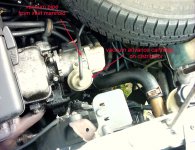Thanks for advice, just changed it. It was indeed a five minute job, once I had spent fifteen minutes scratching my head and wondering how the hell to do it. What I couldn't work out was how to get the white plastic arm over the ball. The solution I came up with goes as follows.
Remove dist cap.
Remove distributor from engine.
Remove breaker and poorly fitting plastic thing.
Remove old vacuum advance.
Remove metal bow-tie shaped thing from top of distributor.
Put a tiny bit of grease on plastic arm, and position under ball joint.
Use a flat head screw driver in slot in plastic arm. Twist a bit to open hole a fraction more.
Use closed circle end of small spanner to hook the plastic arm directly under ball joint and pull up to push plastic arm onto ball joint. N.B. Make sure you do this from the sensible side, which will not leave you with a spanner stuck in your distributor.

Sorry if I'm telling you all how to suck eggs, but this might help a newbie like me.
On the down side I couldn't test it out as I managed to break the plastic tank joint from the top of the radiator, to the thin hose that goes to coolant reservoir :bang: . Oh well, will have to pick one up tomorrow from a scrappie or dealer. Must do this as the panda is going to be tuned in the afternoon.


